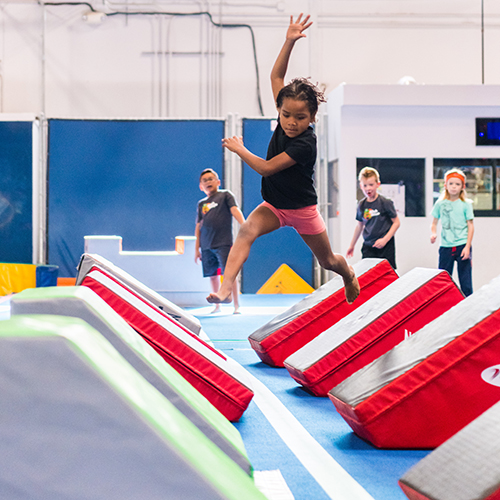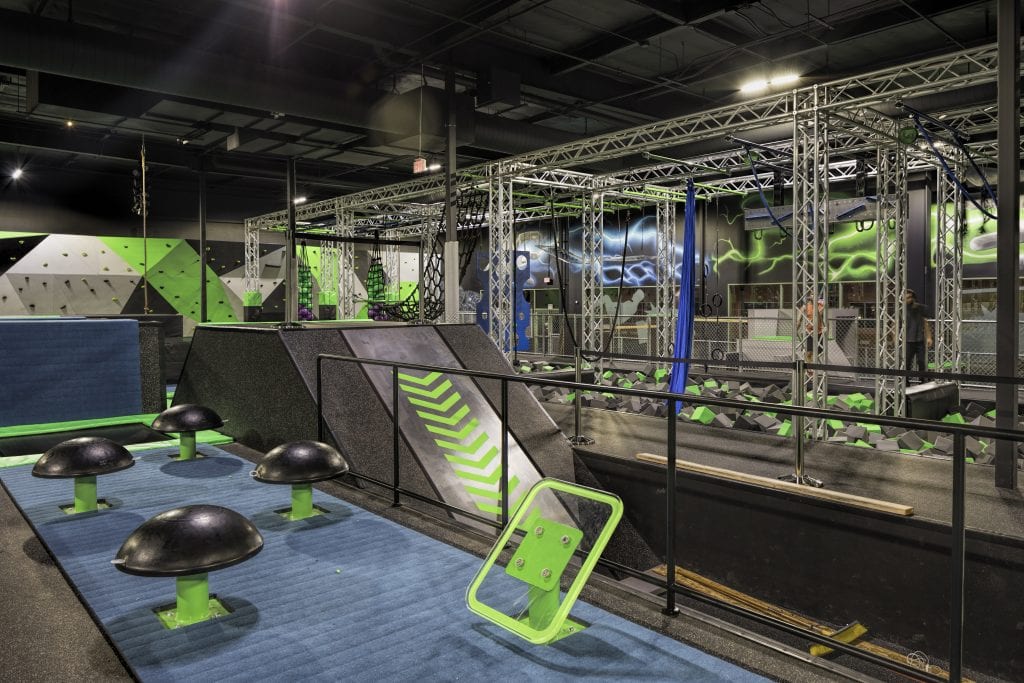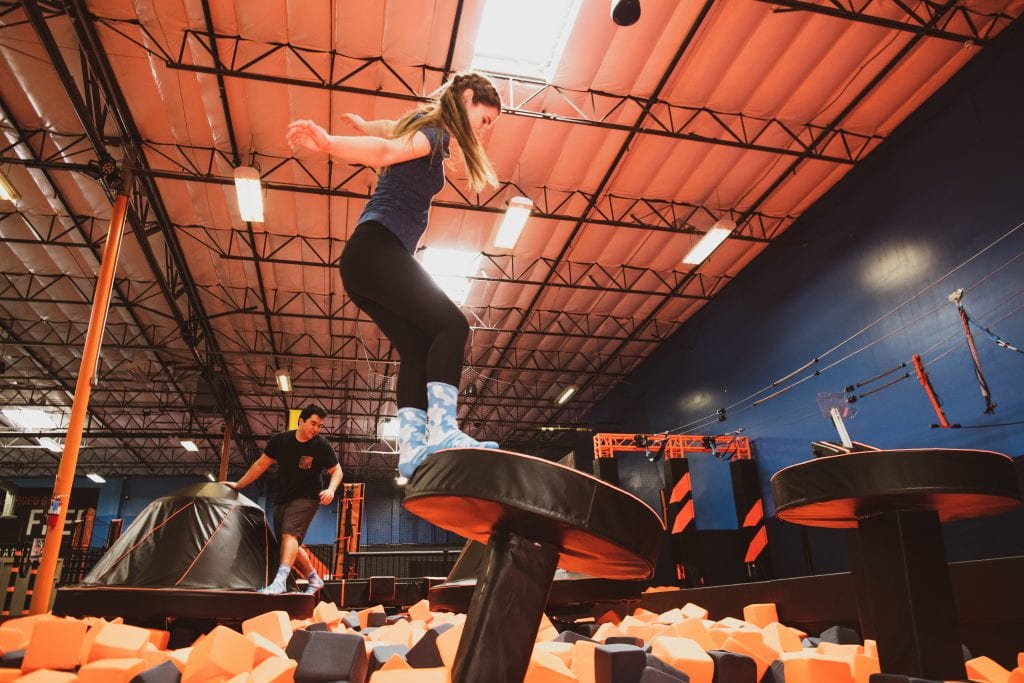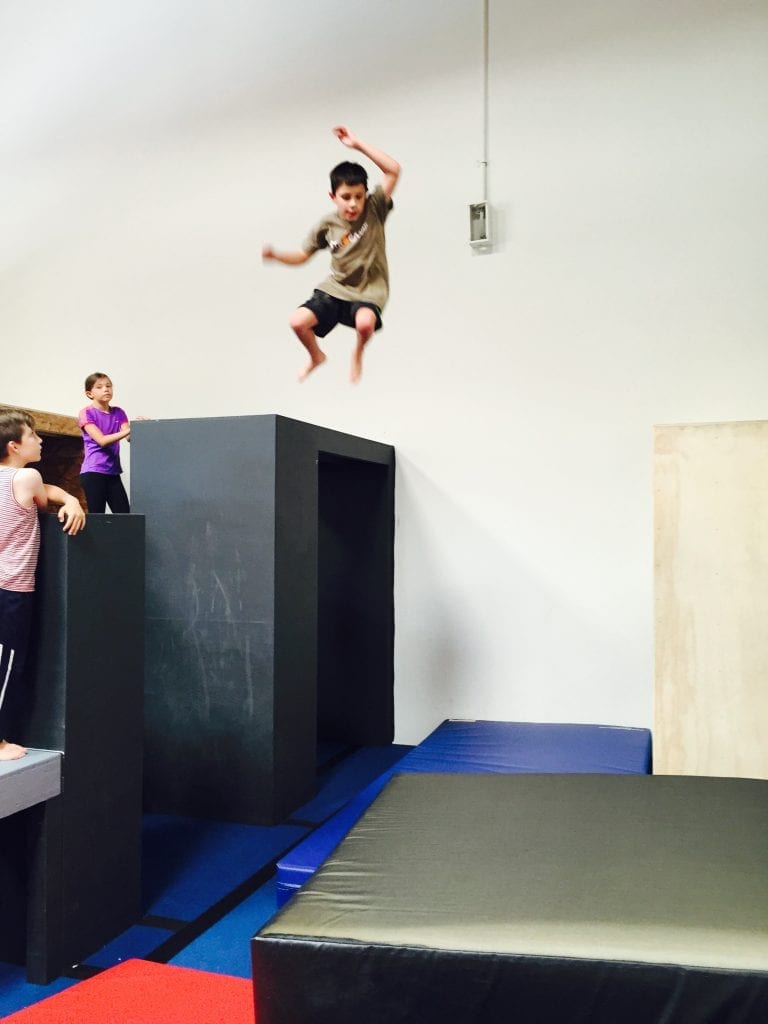
Back in the day, children who enjoyed tumbling and monkey bars might take up gymnastics – and, of course, they still do. A classic never goes out of style. But in the never- ending game of “what’s next?” parkour and freerunning are the trendy new kids on the block. First created by a French physical educator in the early 1900s, parkour focuses on agility and over-coming obstacles using fluid and efficient movement. Freerunning is sort of parkour’s show-offy cousin, incorporating flips and spins on top of parkour’s core philosophy.
In the past 15 years or so, these disciplines have exploded in popularity, thanks to the influence of social and traditional media, beginning with YouTube. With its dawn came new opportunities for individual parkour practitioners (called traceurs) and freerunners to find and learn from each other, as well as build a following.
Some of the best of those early YouTubers got their television break in 2009 when MTV debuted “Ultimate Parkour Challenge,” a competition show that featured six of the top traceurs and freerunners. Just a few months later, NBC launched “American Ninja Warrior,” in which contestants navigate formidable obstacle courses in the pursuit of glory and big cash prizes. The show just finished its 11th season and has made an indelible mark on the culture, con-tinuing to inspire adolescents to climb doorjambs and flip over their sofas. The influence of YouTube and other social media has grown as well. Pop culture references to parkour now abound, and it’s even made its way into the stunningly popular video game Fortnite.
Riding this wave of popularity, a host of SoCal schools and gyms have opened up to spread the gospel. A number of gymnastics schools have also added ninja-type classes to their schedules. For a place where your kids can literally grow by leaps and bounds, check out these spots.
DEFY

Just 10 years ago, trampoline parks were considered a new and exciting concept in recreation. A giant warehouse might hold an expanse of connected trampolines, some angled, perhaps with a basketball hoop at one end and some foam pits.
Today, these parks seem almost quaint, as new spots such as DEFY in Thousand Oaks have raised the bars, so to speak. DEFY, formerly known as DojoBoom (defy.com), is owned by CircusTrix, a company with a network of parks across the U.S., Europe and Asia. The warehouse-size space in Thousand Oaks houses a sizeable trampoline area, giant foam pits, aerial silks, an aerial ninja obstacle course, a rock wall, a flying trapeze and a zipline.
“The pursuit of these motion-based athletics is becoming more popular,” says Kevin Bull, an American Ninja Warrior who is DEFY’s general manager. “Aerial, parkour, trampoline tricking and rock climbing are all about people moving themselves through space in different ways.”
Bull sees the individual nature and relaxed structure of these activities as part of their growing appeal. Each athlete is free to pur-sue their personal best without the constraints of working within a team and, while many of the movements are similar to gymnastics, there isn’t the same focus on symmetry and precision. In parkour, freerunning, or on American Ninja Warrior, there are no grades for style. “It’s about getting past each obstacle and moving forward,” says Bull. The challenge isn’t in doing something with precision, but rather on improvisation and thinking quickly on your feet.
Sky Zone

If DEFY typifies the leading-edge adrenaline park of today, Sky Zone (skyzone.com) is the one that started it all. Founded in 2004, Sky Zone originated the concept of the wall-to-wall trampoline park, a huge innovation at the time. The business has grown to 212 locations worldwide, including those in Van Nuys, Torrance, Covina and Cerritos.
Sky Zone has inspired its fair share of copycats along the way, but has also had to acknowledge newer competitors raising the stakes as they’ve entered the market. “Like a theme park needs to keep putting in new attractions to stay relevant, trampoline parks are the same,” says Chief Marketing Officer Josh Cole. Sky Zones still feature trampoline floors and SkySlam basketball, but have added Ninja Warrior-style obstacle courses to some locations, and “challenge zones” to others, with activities such as foam-padded jousting areas, ziplines and moveable padded parkour blocks.
Sky Zone also operates under the CircusTrix umbrella but main-tains its own brand and identity, and Cole believes the unstructured, unplugged nature of the activities at parks like Sky Zone are its greatest draw. “IPads are great,” he says, “but as a parent, it’s nice to see your kids get off the couch and engage in some active free play – whether that’s jumping on the trampolines or learning how to flip off of the side wall parkour-style, or trying to knock your brother off – or dad off, or mom off – the balance beam.”
Tempest Freerunning Academy
Tucked into a back corner of an office park in Chatsworth, Tempest Freerunning Academy’s (tempestacademy.com) Valley location looks like an anonymous warehouse from the outside. Inside, however, it’s a brightly colored, graffitied, faux-urban landscape with warped walls to run up, straight walls for scaling, high bars for swinging and flipping, platforms of varying heights for climbing on and jumping off and foam pits for soft landing. Every student begins instruction at the same beginners’ level, and emphasis is placed on progressions and learning from a solid base. Students test every 10 weeks to determine whether they’re ready to move to the next level. They learn all the basics of how to navigate smoothly through the obstacles before learning flipping and tricking.
Tempest’s facilities, which also include locations in Hawthorne, Vista and Southlake, Texas, feature state-of-the-art spaces dedi-cated solely to teaching freerunning and parkour. Instructors are all freerunning professionals with years of experience.
Naheed Nunez is Tempest’s regional manager. Her husband, Gabe Nunez, is one of the founders of Tempest and also a major figure in U.S. freerunning. Naheed has been involved with Tempest since its inception in 2010 and says she is moved by the impact it has on students. “Just seeing the way some students come in, some of them are not athletes,” she says. “It’s really a mental and physical thing. They’re overcoming obstacles physically, trying new things and doing things they never thought they could do, and it’s really cool to see them grow mentally as well. They build confidence.”

Daniella Ezra has seen the benefits for her 8-year-old son, Na-than. “The coaches are young, energetic, friendly, and teach the kids real skills,” she says. “Nathan has definitely gotten stronger since he started. I watch him jump and flip and hang on things high up, and all with a smile on his face.”
The Klub Gymnastics
As its name implies, The Klub Gymnastics (gymnasticslosangeles. com) is first and foremost a gymnastics school, and a beloved one at that. What began in 2005 as a mobile class, with owner Mike Eschenbrenner traveling to various after-school programs in a van, found a home at Silverlake Independent Jewish Community Center about a year later. Within 10 years, the school had far outgrown its space and moved in 2016 into a 40,000-square-foot facility in Frogtown. The added room has allowed Eschenbrenner and co-owner Edward Yonek to expand their offerings in a number of directions, including the addition of an obstacle course-based program called Club Ninja.
“It’s a program that took off massively, right away,” Eschenbrenner says. “It took us about three months to set it up, and we had a waitlist growing from the moment we announced it.”
It’s a trend Eschenbrenner sees happening across gymnastics schools. “It kind of started as a way to bring the boys back into the program,” he says. “Generally, boys start to lose interest around 8 or 9 years old, when team sports start to take effect. So, Ninja was kind of a way to get those boys back in. And it turns out, that although that does work, a lot of our Ninja kids are girls.”
In Klub Ninja classes, there’s no flipping or tricking allowed, per the school’s insurance policy. However, Eschenbrenner points out the facility’s “beautiful structure that’s like monkey bars on steroids,” which is also used during the Klub’s Ninja tournaments, held on select Saturdays. The benefits of obstacle work include strength, balance and co-ordination. “These kids are doing conditioning the whole time. They don’t know it, but they’re doing pushups and ab work,” Eschenbrenner says. “You’re just hiding it in all this fun.”
Aerial Warehouse

Billing itself as the place “where Cirque du Soleil meets American Ninja Warrior,” Aerial Warehouse (aerialwarehouse.com) in Culver City offers aerial classes that focus on circus arts and action arts, and parkour classes that teach all the elements of parkour and freerunning. It’s the brainchild of Shana Lord, her husband, Chris Solomon, and their business partner and friend, Wendy Turner.
Lord and Solomon have backgrounds in acrobatics, and Lord got to know Turner over many years of teaching Turner’s children acrobatics and aerial arts. The two eventually realized they had a common vision for a school. “We really got along on what it was that we were after for our kids,” Lord says. They imagined a place where kids could gain strength and confidence in a noncompetitive environment, learning lessons about personal growth through small but steady progression, that they could then apply to any challenge in life.
The school’s Action Arts and Parkour program teaches what Lord calls “playground skills.” It’s not just parkour, and not simply obstacle courses. The goal is for the curriculum to be well-rounded, to create kids with well-rounded capabilities. There’s efficient movement training, but also elements of gymnastics, such as tumbling and trampoline.
“The Action Arts program is where our parkour and tumbling and trampoline and open gymnastics services live,” Lord says. Their goal was an environment where students wouldn’t hear, “Point your toes and get a 10 out of 10,” but rather, “Let’s figure out a way to have this sort of efficient movement-slash-pilates-slash fitness and make it really fun and get it in on a ground level with kids,” she explains.
Lord confesses that she was a nervous parent on the playground when her kids were young because injuries can happen seemingly out of nowhere. “When the body trains to innately do things,” Lord says, “that keeps them a lot safer out there, when they’re walking around, jumping over logs, doing whatever it is that they’re doing. They just start to have these movement patterns that assist them.”
Urban gymnastics. Parkour. Freerunning. Ninja. The names might vary, but the focus is largely the same: training the body to overcome obstacles. It’s part of a larger common ethos that’s tough to argue with – one that values the pursuit of fitness, personal strength, agility and joy.
Keren Engelberg is a writer and editor covering parenting, food, travel and lifestyle. She has written for The Los Angeles Times and Westways magazine, and lives with her husband, two sons and mini goldendoodle in Los Angeles.




























